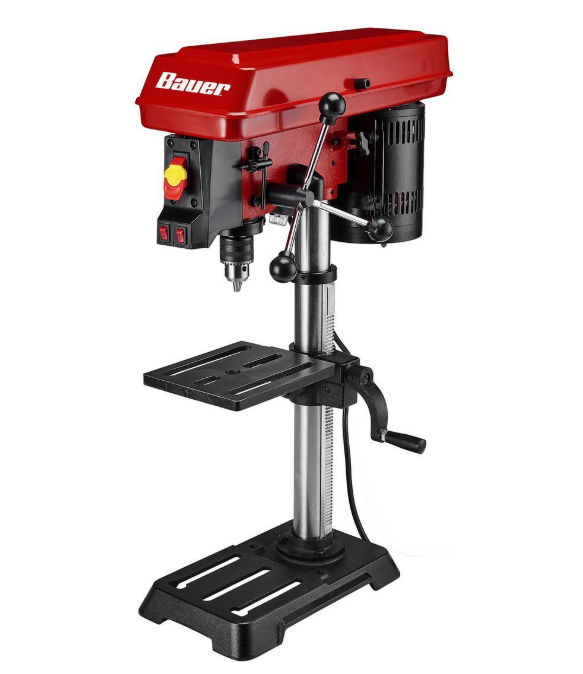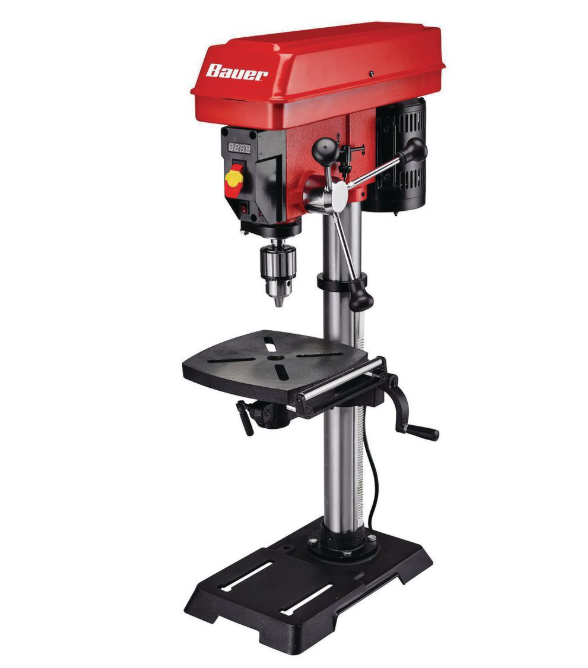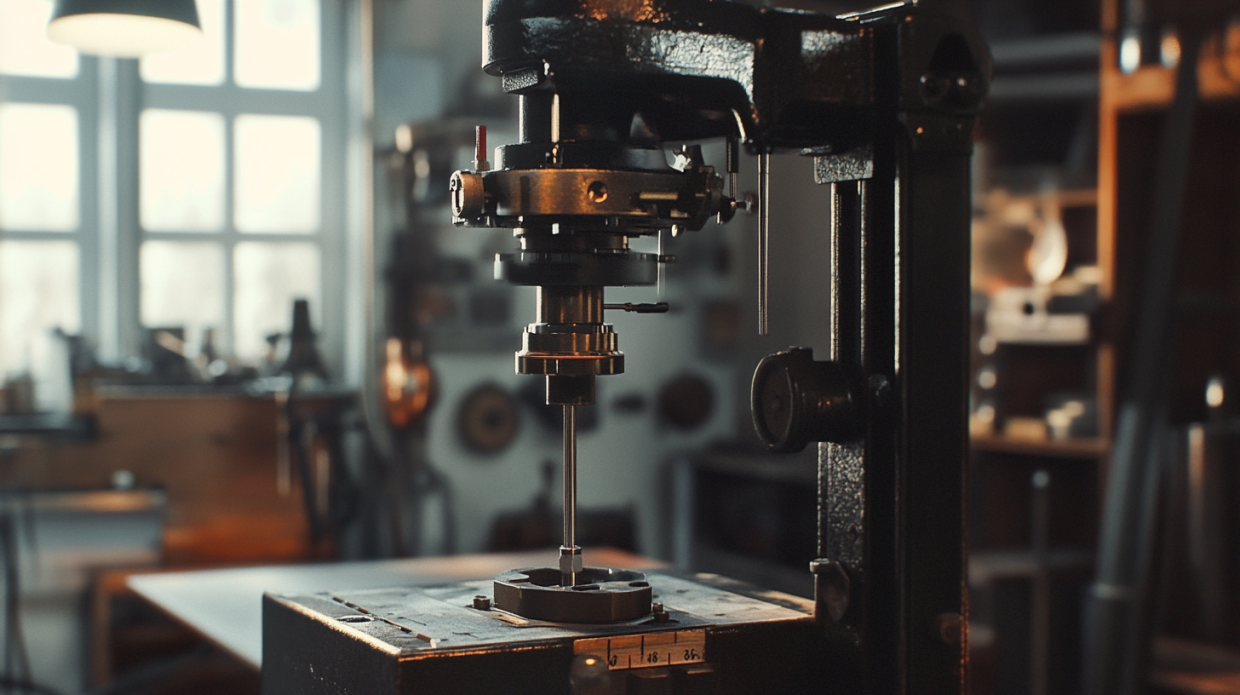
BAUER 10 in., 5-Speed Bench Drill Press with Light
- 5 adjustable speeds from 630 to 3300 RPM
- Large 6-1/2 in. x 7-1/2 in. work table tilts 45° left and right
- Built-in LED worklight for optimal visibility
- Laser crosshair drill point for precise alignment
- Heavy duty cast iron base for improved stability

BAUER 12 in. Variable-Speed Drill Press with Laser Alignment
- Powerful 2/3 HP, 6.2 amp motor
- Variable speed from 580 RPM to 3200 RPM
- 9-1/2 in. x 9-1/2 in. cast-iron table rotates 360° and tilts up 45° left and right (for angled drilling operations)
- Built-in LED work light for a clear view of the work area
How This Affordable Powerhouse Can Transform Your DIY and Professional Projects
When it comes to precision drilling, few tools offer the combination of accuracy, stability, and versatility that a quality drill press provides. Among the growing number of options available to today’s craftsmen and DIY enthusiasts, the Bauer Drill Press has emerged as a compelling choice that balances performance and affordability. Whether you’re a weekend woodworker, a dedicated hobbyist, or a professional seeking reliable workshop equipment, understanding what the Bauer drill press offers can help you determine if it deserves a place in your tool arsenal.
The Evolution of Workshop Precision
I still remember my first drilling project—attempting to create perfectly aligned holes for cabinet hardware using just a handheld drill. The results were predictably disappointing, with misaligned holes and an end product that screamed “amateur.” That frustrating experience led me down the path to discovering drill presses, and eventually, to evaluating options like the Bauer drill press line.
The precision that comes from a dedicated drill press simply cannot be matched by handheld alternatives. With a stable platform, consistent depth control, and the ability to maintain perfect perpendicularity to your workpiece, a drill press transforms tedious drilling tasks into satisfyingly precise operations. But not all drill presses are created equal, and finding the right balance of quality, features, and price point is crucial for both hobbyists and professionals.
Understanding the Bauer Drill Press: Basics and Specifications
Bauer, a brand carried exclusively by Harbor Freight, has positioned itself in the power tool market as offering “professional performance at practical prices.” Their drill press line embodies this philosophy, providing substantial capabilities without the premium price tag of some competitor brands.
The Bauer drill press is designed with the serious DIY enthusiast and value-conscious professional in mind. Available in both benchtop and floor-standing models, these machines feature robust construction with cast iron components for stability and durability during operation. The standard benchtop model stands at approximately 23 inches tall, making it compact enough for most workbenches while still offering significant drilling capacity.
Power and Performance Specifications
At the heart of the Bauer drill press is its motor, which typically delivers 3.2 amps of power, translating to roughly 1/3 horsepower. While this might not match the raw power of industrial-grade drill presses costing three to four times as much, it provides more than adequate performance for the vast majority of woodworking, metalworking, and general fabrication tasks undertaken in home workshops and small professional settings.
The Bauer press offers a 5-speed belt-drive system, allowing users to adjust the rotation speed between 760 and 3070 RPM. This range enables appropriate speed selection for different materials and bit sizes—slower speeds for drilling through metals and harder materials, and higher speeds for wood and plastics. While not offering the infinite variability of some higher-end models with electronic speed control, the five distinct settings cover the necessary range for most applications.
Drilling Capacity and Chuck Specifications
One of the most important specifications for any drill press is its maximum drilling capacity. The Bauer benchtop model offers a respectable 2-inch drilling capacity, meaning it can effectively create holes up to 2 inches in diameter in wood (with appropriate bits, of course). For metal, the practical capacity is naturally lower—around 1/2 inch for mild steel—which aligns with most DIY and light commercial applications.
The drill press comes equipped with a standard 1/2-inch chuck, which accepts the vast majority of commonly used drill bits. This JT33 chuck is compatible with straight-shank bits ranging from tiny 1/16-inch bits up to 1/2-inch diameter shanks. For larger bits with 1/2-inch shanks (like Forstner bits or hole saws), the chuck accommodates them perfectly, making the Bauer suitable for furniture-making, cabinet construction, and similar woodworking applications.
Cost and Value Proposition
In the tool world, price often strongly correlates with quality and features, but occasionally you find that sweet spot where value exceeds expectations. The Bauer drill press currently retails for approximately $179.99 for the benchtop model, positioning it firmly in the mid-range of consumer-grade drill presses.
Compared to budget models that might sell for $100-130 with significantly less robust construction, and professional-grade benchtop models that can easily exceed $300-400, the Bauer occupies an attractive middle ground. It offers cast iron construction elements typically found in more expensive models while maintaining a price point accessible to serious hobbyists and value-conscious professionals.
For those requiring the additional capacity and floor space of a standing model, the Bauer floor drill press typically sells for around $249.99. This represents a similar value proposition in the floor-standing category, where comparable models from other manufacturers often start at $350 and quickly climb above $500.
Where to Purchase
As mentioned earlier, Bauer is an exclusive brand carried by Harbor Freight Tools. This means that your purchasing options are limited to Harbor Freight’s physical retail locations (of which there are over 1,000 across the United States) or through their official website. This exclusivity can be either a limitation or a convenience, depending on your proximity to a Harbor Freight store.
The advantage of purchasing in-store is the ability to see the drill press in person before buying, as well as easier transport home (these machines, particularly the floor-standing models, are quite heavy). However, online purchasing through Harbor Freight’s website offers the convenience of home delivery, though shipping costs should be factored into your budget due to the weight of these items.
Harbor Freight frequently offers sales and coupon discounts, sometimes reducing the price of the Bauer drill press by 10-20%. Savvy shoppers who can time their purchase with these promotional periods can further enhance the already strong value proposition of these machines.
Workshop Versatility: Materials and Applications
A drill press is one of those workshop tools that, once acquired, reveals itself to be surprisingly versatile. The Bauer drill press exemplifies this versatility through its ability to work effectively across multiple materials and applications.
Wood Working Capabilities
For woodworkers, the Bauer drill press excels at creating clean, precise holes for joinery, hardware installation, and decorative elements. The 3070 RPM maximum speed is ideal for clean drilling in softwoods and hardwoods alike. The substantial table size (approximately 8 x 8 inches on the benchtop model) provides adequate support for most woodworking projects.
When equipped with Forstner bits, the Bauer makes quick work of flat-bottomed holes for concealed hinges and similar hardware. For through-holes, the included table insert helps prevent tear-out on the bottom face of your workpiece. While dedicated woodworking drill presses might offer larger tables or more specialized features, the Bauer provides all the essential capabilities needed for furniture construction, cabinetry, and general woodcraft.
Metal Working Performance
Perhaps surprisingly for its price point, the Bauer drill press handles metalworking tasks with impressive competence. The lowest speed setting of 760 RPM is appropriate for drilling into mild steel with high-speed steel (HSS) bits, while the robust cast iron construction minimizes vibration that can lead to wandering bits and oversized holes.
While it wouldn’t be my first choice for production metal fabrication shops, the Bauer is more than capable of handling occasional metal drilling for home projects, automotive repair, and light fabrication work. I’ve successfully used mine to drill precise holes in 1/4-inch steel plate for mounting brackets and similar applications, achieving clean results with the appropriate cutting fluid and patience.
Plastic and Composite Materials
The variable speed settings make the Bauer particularly adept at working with plastics and composite materials, which often require specific drilling speeds to prevent melting or chipping. The middle speed ranges (around 1220-2450 RPM) are ideal for most plastic drilling applications, allowing for clean holes without heat buildup that can deform the material.
For hobbyists working with circuit boards, model building, or similar precision applications involving plastics and composites, the stability and speed control of the Bauer drill press provides significant advantages over handheld drilling options.
Table Features and Workpiece Support
The worktable is a critical component of any drill press, serving as the platform that supports and positions your workpiece relative to the drill bit. The Bauer drill press features a cast iron table measuring approximately 8 x 8 inches on the benchtop model (10 x 10 inches on the floor-standing version), providing a stable platform for most common workpieces.
Table Adjustability
One of the more valuable features of the Bauer’s table is its tilting capability, allowing for angled drilling operations. The table can be adjusted from 0 to 45 degrees in either direction (left or right), enabling angled holes for specialized joinery, decorative effects, or mechanical applications requiring non-perpendicular drilling.
The table height is adjustable via a rack-and-pinion mechanism, allowing you to position the work surface at the optimal height for different workpiece thicknesses and drilling depths. This adjustment is smooth and precise, with a locking mechanism to secure the table firmly once positioned.
Workpiece Clamping and Fixturing
While the Bauer drill press does not come with built-in T-slots or a fence system (features found on some higher-end, woodworking-specific drill presses), the flat cast iron table readily accepts aftermarket fixtures and clamps. Many users enhance their Bauer press with simple shop-made jigs or commercially available drill press vises to expand its capabilities.
For those working with smaller or irregularly shaped workpieces, adding a drill press vise is almost essential. These range from simple cross-vise designs costing around $25-30 to more elaborate quick-release models in the $50-100 range. The investment in proper workholding accessories dramatically expands the utility and safety of your drill press operations.
Precision Features: Depth Stop and Laser Guide
Precision is the primary reason for choosing a drill press over a handheld drill, and the Bauer incorporates several features designed to enhance accuracy and repeatability.
Depth Stop System
The Bauer drill press includes a depth stop mechanism that allows users to preset the maximum drilling depth for consistent, repeatable results. This feature is invaluable for operations like drilling shelf pin holes, stopped dados, or any application requiring multiple holes of identical depth.
The depth stop consists of a threaded rod with adjustable nuts that limit the downward travel of the quill. While not as sophisticated as the digital depth stops found on premium machines, the Bauer’s mechanical system is straightforward, reliable, and perfectly adequate for most applications. I’ve found it maintains its setting reliably even through extended drilling sessions, a testament to the overall build quality.
Laser Alignment Guide
One of the more modern features included with the Bauer drill press is a built-in laser crosshair system. This projects intersecting red laser lines onto your workpiece, indicating precisely where the drill bit will make contact. For applications requiring exact bit placement, this feature significantly enhances accuracy and reduces setup time.
The laser is battery-powered (typically using two AA batteries) and can be switched on independently of the main motor. In practical use, I’ve found the laser alignment to be surprisingly accurate, though as with any such system, it’s wise to verify alignment periodically, especially after transporting or adjusting the machine.
While some might consider a laser guide to be a luxury feature, its inclusion on a drill press in this price range represents significant value. For intricate work like drilling perfectly centered holes in furniture components or aligning holes for hardware installation, the time saved and precision gained make this feature well worth having.
Size, Weight, and Workshop Placement
Workshop space is precious for most of us, making the physical dimensions and weight of any new tool an important consideration. The Bauer benchtop drill press has a footprint of approximately 15 x 10 inches and stands about 23 inches tall, making it compact enough for most workbenches while still providing substantial drilling capacity.
The floor-standing model, naturally, requires more space with its full-height design (approximately 63 inches tall) and larger footprint. However, it offers additional drilling capacity and workspace clearance that can be worth the extra space requirement for many users.
Weight and Stability Considerations
The benchtop Bauer model weighs approximately 55 pounds, while the floor-standing version comes in at around 125 pounds. This substantial weight is actually a benefit in use, as mass contributes significantly to stability and vibration damping during operation.
For the benchtop model, I strongly recommend mounting it to a solid, heavy workbench rather than a lightweight portable table. The additional mass of a substantial bench further improves performance by minimizing vibration during drilling operations. Some users opt to bolt their benchtop drill press to a dedicated mobile base with additional weight added, creating a compromise between portability and stability.
Warranty and Customer Support
Harbor Freight backs the Bauer drill press with a 90-day satisfaction guarantee and a 2-year limited warranty. While this warranty period is shorter than the 3-5 years offered by some premium tool brands, it reflects the value-oriented positioning of the Bauer line and still provides reasonable protection against manufacturing defects.
My experience with Harbor Freight’s customer service has been generally positive, with representatives being knowledgeable about their product lines and helpful in resolving issues. For warranty service, you’ll typically need to return the tool to a physical Harbor Freight location, which is worth considering if you don’t live near one of their stores.
Professional vs. Hobbyist Use: Is Bauer Right for Your Needs?
One of the most common questions about the Bauer drill press concerns its suitability for professional use. The answer, as with many tools in this price range, depends entirely on the intended application and frequency of use.
For Professional Workshops
For professional woodworkers, fabricators, or machinists who rely on their drill press for daily, heavy-duty use, the Bauer represents a viable entry-level option but may not offer the durability or advanced features of commercial-grade equipment. Professional users should view the Bauer as a capable light-duty machine or backup press rather than a primary production tool.
That said, many small professional shops operating with tight budget constraints have successfully incorporated Bauer drill presses into their workflow, particularly for lighter-duty or occasional drilling operations. The value proposition is compelling enough that some professionals choose to purchase a Bauer for specific applications while maintaining higher-end equipment for their most demanding work.
For Home Workshops and Hobbyists
For home woodworkers, DIY enthusiasts, and hobbyists, the Bauer drill press represents an excellent balance of capability and value. Its specifications and features match or exceed the requirements for virtually all home workshop applications, from furniture building to craft projects to home repair tasks.
The build quality, while not matching industrial-grade machines, is substantially better than entry-level models and should provide many years of reliable service in a hobbyist setting. For the vast majority of home users, the Bauer offers all the precision, power, and features needed without unnecessary cost.
Chuck Size and Bit Compatibility
The Bauer drill press comes equipped with a 1/2-inch chuck, which is the standard size for most consumer and prosumer-grade drill presses. This chuck size accepts bits with shanks up to 1/2 inch in diameter, encompassing the vast majority of drill bits used in woodworking, metalworking, and general fabrication.
Compatible Bit Types
With its 1/2-inch chuck, the Bauer drill press can use:
- Standard twist drill bits (from tiny 1/16″ bits up to 1/2″ shanks)
- Forstner bits (for clean, flat-bottomed holes in wood)
- Spade bits (for rough construction holes)
- Hole saws (for larger diameter holes)
- Countersinks and counterbores
- Specialty bits like brad-point and auger bits
For bits larger than 1/2-inch shank diameter, adapters or reduced-shank versions are available, though using very large bits may exceed the motor’s power capacity, particularly in harder materials.
Chuck Quality and Runout
The chuck that comes with the Bauer drill press is a standard keyed chuck of reasonable quality. In my testing, it exhibited minimal runout (the deviation from perfect rotation), which is crucial for precise drilling operations. While not matching the precision of premium chucks found on industrial equipment, it performs admirably within its price category.
For those seeking absolute precision for specialized applications, the chuck can be upgraded to an aftermarket precision chuck, though this represents a significant additional investment relative to the machine’s cost.
Assembly and Setup Experience
Like most drill presses in its class, the Bauer arrives partially disassembled to reduce shipping size and cost. Assembly is straightforward but does require some time and basic mechanical aptitude.
What to Expect During Assembly
The typical assembly process involves:
- Attaching the column to the base
- Mounting the table and rack assembly
- Installing the head assembly onto the column
- Mounting the chuck to the spindle
- Installing handles and adjusting tension belts
Most users report completing assembly in 1-2 hours with basic hand tools. The instruction manual is clear and well-illustrated, making the process accessible even for those with limited mechanical experience. All necessary hardware is included, though having your own wrench set and screwdrivers often makes the job easier than using the included tools.
Initial Setup and Adjustments
After physical assembly, several adjustments should be made to ensure optimal performance:
- Checking and adjusting table perpendicularity to the spindle
- Verifying the laser alignment (if equipped)
- Setting proper belt tension
- Lubricating moving components per the manual’s recommendations
Taking the time to properly set up these adjustments pays dividends in improved accuracy and performance. I particularly recommend checking the table’s perpendicularity with a machinist’s square or similar tool, as this fundamental alignment affects all drilling operations.
Replacement Parts and Long-Term Ownership
One advantage of purchasing a tool from a widespread retailer like Harbor Freight is the availability of replacement parts. Common wear items for the Bauer drill press include:
- Drive belts
- Chuck key
- Table lock handles
- Motor brushes
These parts can be ordered directly through Harbor Freight’s parts department, either in-store or online. For mechanical components that might eventually wear out with heavy use, knowing that replacements are readily available provides peace of mind for long-term ownership.
Safety Features and Best Practices
Drill presses, like all power tools, require attention to safety. The Bauer includes several standard safety features:
- A safety switch cover that prevents accidental starting
- A chuck key with spring-loaded ejection to prevent leaving it in the chuck
- A belt and pulley guard to prevent contact with moving parts
These features provide basic protection, but safe operation ultimately depends on user practices. I strongly recommend:
- Always securing your workpiece with appropriate clamps or vises
- Wearing safety glasses during all drilling operations
- Removing loose clothing and jewelry before operating
- Using appropriate speeds for the material and bit size
- Regular maintenance and inspection of all components
For newer users, I suggest practicing on scrap material before attempting precision work on valuable workpieces. This not only builds skill but also familiarizes you with the machine’s behavior and capabilities in a low-pressure context.
User Reviews and Community Feedback
The Bauer drill press has garnered generally positive reviews from users, with most citing its excellent value proposition and surprising capability for its price point. On Harbor Freight’s website, the benchtop model typically maintains a rating above 4 stars, with particular praise for its stability, power, and included features like the laser guide.
Common criticisms tend to focus on:
- Limited table size compared to specialized woodworking drill presses
- The basic nature of the depth stop mechanism
- Occasional quality control issues with specific units
The workshop community’s consensus seems to be that while the Bauer doesn’t match the refinement or durability of premium brands costing 2-3 times as much, it delivers 80-90% of the functionality at a fraction of the price. For most users, this represents an excellent value proposition and explains the growing popularity of these machines in home workshops.
Maintenance and Care for Long-Term Performance
Like any precision tool, a drill press requires regular maintenance to deliver consistent performance over years of use. The Bauer is designed for relatively low maintenance, but attention to a few key areas will significantly extend its service life.
Regular Maintenance Tasks
To keep your Bauer drill press in optimal condition:
- Regularly clean sawdust and metal chips from all surfaces, particularly the column and quill. Compressed air works well for this, but always wear eye protection.
- Apply light machine oil to the column periodically to ensure smooth table movement and prevent rust.
- Check belt tension monthly and adjust as needed. Proper belt tension reduces wear and improves power transfer.
- Inspect the chuck jaws for debris that might prevent proper bit centering.
- Lubricate moving parts according to the manual’s recommendations, typically every 6-12 months depending on usage.
For those in humid environments, applying a light coat of paste wax to cast iron surfaces (like the table) helps prevent rust without attracting dust or affecting workpiece grip.
Long-Term Care
With proper care, a Bauer drill press should provide many years of reliable service in hobbyist and light professional settings. After several years of regular use, you might need to:
- Replace drive belts if they show cracking or stretching
- Check motor brushes (if accessible) and replace if worn
- Re-align the laser guide if it drifts from calibration
- Tighten any fasteners that may have loosened with vibration
Taking these simple maintenance steps dramatically extends the useful life of the machine and preserves its accuracy and performance characteristics.
Conclusion: Is the Bauer Drill Press Right for You?
After examining all aspects of the Bauer drill press—from specifications and features to real-world performance and value—the conclusion largely depends on your specific needs and expectations.
For hobbyists, DIY enthusiasts, and even professionals with light-duty needs, the Bauer drill press represents an excellent value proposition. It offers substantial capability, reasonable build quality, and helpful features at a price point that’s accessible to most workshop budgets. The combination of cast iron construction, adequate power, and precision features like the laser guide and depth stop make it a worthy addition to any growing workshop.
For heavy production environments or users requiring absolute precision for specialized applications, the Bauer may serve as a capable secondary machine but likely wouldn’t replace industrial-grade equipment costing several times as much.
Ultimately, tools should be judged not by their price tag or brand prestige, but by how effectively they enable you to complete your projects with the required level of quality and efficiency. By this practical standard, the Bauer drill press earns its place as a worthy contender in the mid-range drill press market—delivering professional-adjacent capabilities at a decidedly budget-friendly price point.
Whether you’re drilling precise dowel holes for fine furniture, creating mounting holes for a metal project, or simply adding a versatile drilling station to your workshop, the Bauer drill press offers the essential capabilities needed for success without unnecessary cost. And in today’s workshop environment, that balanced approach to value and performance is increasingly difficult to find.

